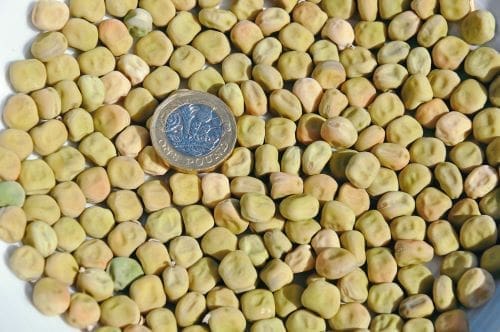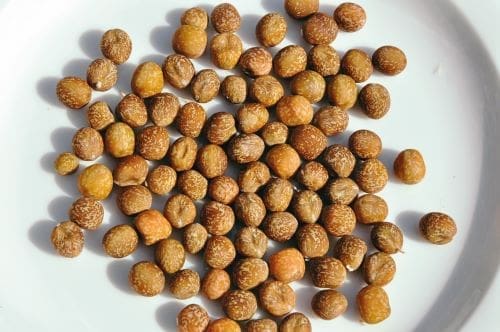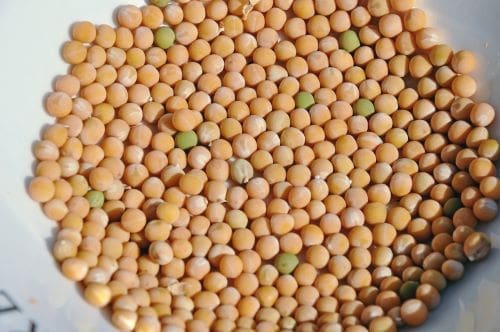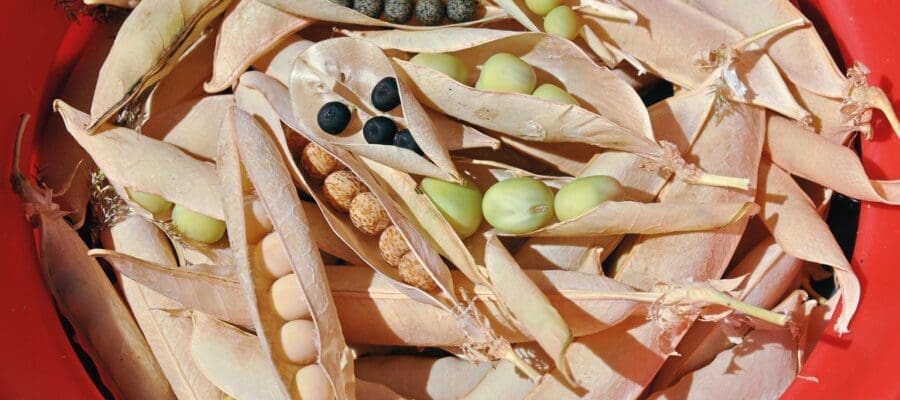Green beans and peas are a national favourite, yet relatively few UK gardeners grow them for drying. KG editor Steve Ott offers some advice on growing and storing these nutritious crops.

Rather than turning to GM to feed an ever-growing population, some experts believe we should plant more pulses (peas and beans) for drying. They certainly have lots going for them: they are highly nutritious, containing lots of protein, fibre and essential nutrients and are low in fat. The British Heart Foundation recommends them to reduce the risk of heart disease and strokes.
In the garden, drying (or shelling) varieties are easy to grow and productive; climbing types make use of vertical space and can be used to provide shade for other crops. A few are known for their drought tolerance (e.g. tepary beans) and all love sunshine, an advantage as our summers become ever warmer and drier.
They’re not a quick crop – you’re harvesting dried peas and beans a few weeks later than you would green crops planted at the same time as the seed must be fully mature.
If you’re planning to store them, you need to wait a bit longer for the peas to fully dry – especially the larger-seeded varieties such as ‘Holland Capucijners’.
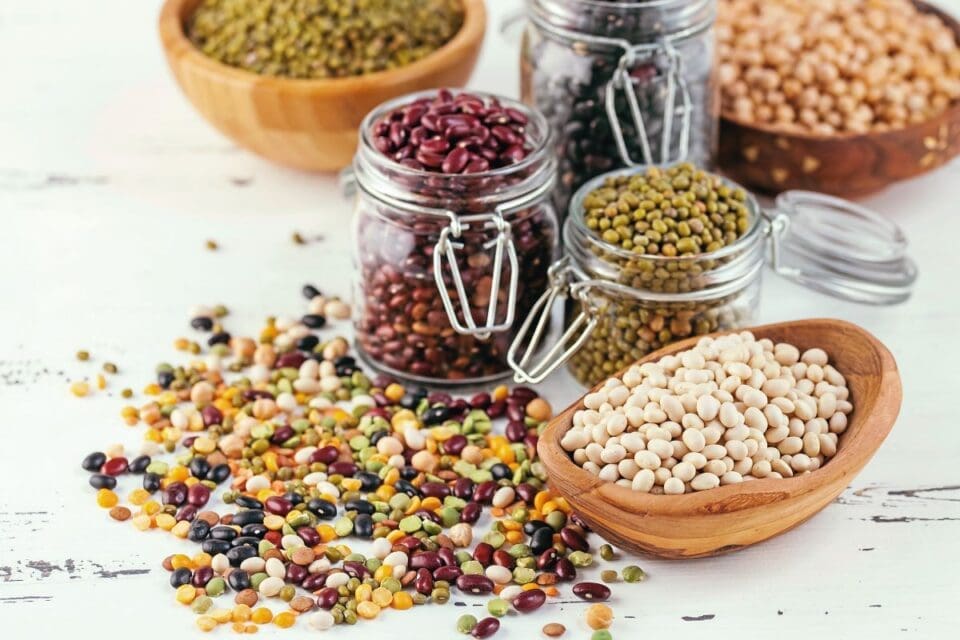
Sourcing the seeds
If you’ve ever grown beans such as runners or dwarf French beans, or green peas for eating fresh, you’ll know exactly how to grow drying varieties and in theory any variety of pea or bean could be used for drying. However, there are literally hundreds of varieties which have been bred specifically for this purpose, particularly on the Continent where they are a staple. Some are hundreds of years old and specific to a region or regional dish where they have taken on mythical status.
In the UK a lack of tradition for these crops means that seeds are a little harder to come by. However, some excellent seed companies such as Real Seeds and Seeds of Italy supply a good range and if you are a member of The Heritage Seed Library, part of Garden Organic, you will also find some on its annual seed list which is available to members.
It is also possible to grow them from shop-bought seeds and I’ve been experimenting with some unusual ones such as moth beans and ‘Maris Bead’ fava or broad beans. The latter are great for soups, stews, curries and home-made baked beans.
The good news is that once you have them, they are easy to save for future use since being self-fertile they usually remain true to type.
Sowing
All types of drying beans (apart from some broad or field beans) are frost tender. Some such as the haricot or navy bean used in tinned baked beans are only likely to be very successful in warmer parts of the UK. But that’s okay as many other types of beans make delicious home-made baked beans!
Sow beans about a month before the last frost in your area and maintain a temperature of around 12C (54F) or above. Many of the peas are quite hardy and I start them off in an unheated greenhouse February onwards, which gives them the long growing season they require. Sow into Rootrainers, small pots or cell trays. Peas can also be sown in guttering. Plant out beans after the last frost in your area. Peas can be planted out from late March onwards after hardening off thoroughly.
Choose a sunny site for your peas and beans – this is even more important for drying types to help ensure the pods dry quickly and thoroughly on the plants. It should also be sheltered if possible so that supports for climbing types are not tested too much by strong winds.
The soil should be free draining, but with plenty of organic matter added to help it retain water during dry spells. Other than that, peas and beans are not too fussy about soil type and special nodules on the roots, which are home to nitrogen-fixing bacteria, help to keep plants supplied without the need to feed too generously. However, a topdressing of 56g per sq m (2oz per sq yd) of blood, fish and bone or any other general fertiliser before sowing or planting will get them off to a good start.

Supporting
Climbing types will require reasonably strong supports and since some can easily reach 2.7m (9ft), they may need to be tall, but check the seed packet for information on your chosen variety. Strong tree/fencing stakes are ideal with strings or jute netting strung between them, or wigwams made from bamboo or hazel poles, but of course there are also lots of excellent kits you can buy to support your climbing crops.

Planting
Plant your beans and peas at the base of the supports, in the case of beans generally about 10-15cm (4-6in) apart and 8cm (3in) apart for peas. They may need to be encouraged to connect with the netting or strings at first but will soon get to grips and grow away.
General care
Maintain watering during dry spells (this also helps to delay powdery mildew on peas) and feed occasionally with a high-potash liquid feed such as a tomato or comfrey feed or if you don’t have that, a balanced feed such as liquid Growmore or a seaweed-based feed. Tie in wayward shoots and weed around the base of the plants to prevent competition.
Your plants will grow and flower with very little care and attention, and being largely self-fertile, pods should set freely.
Harvesting
This is where growing drying peas and beans differs from growing for eating fresh or freezing. It is important not to pick the pods before they have completely dried, yet they do need to be gathered before the pods split and the seeds are lost.
Pea plants and pods will take on a lovely golden straw colour when they have properly dried. In a hot year you can dry the pods on the vine outside, but it’s more likely you’ll need to take them indoors – I pull mine up and hang them in the polytunnel for a few weeks, harvesting the pods as they mature, although if you have a huge crop, you’d probably wait for most of them to dry and pod them all in one go.
You can tell that the peas are mature and ready to be podded if they rattle around in their brown, crisp and papery pods. As you remove the peas, check for any signs of pea moth and discard any damaged seeds.
The peas will probably seem dry but may still not be dry enough for storage at this stage.
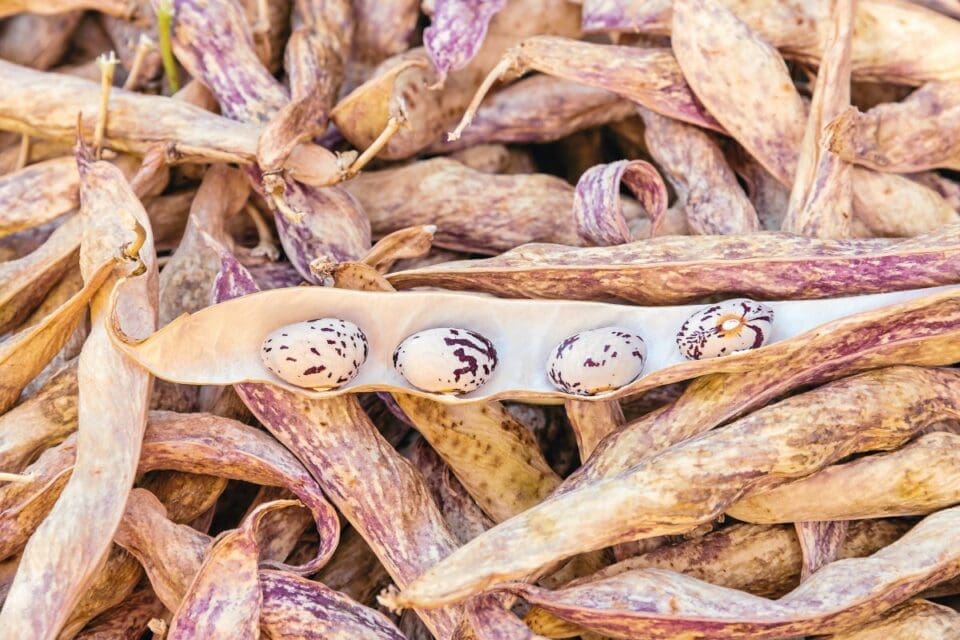
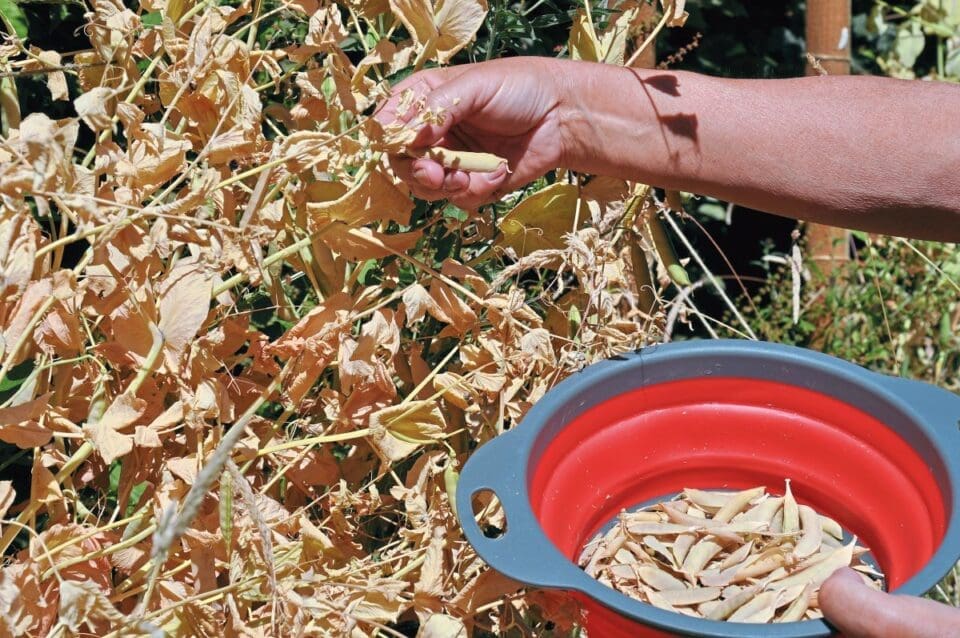
Beans are ready when the pods have turned brown and start to split open naturally. Harvest just before the seeds fall to the ground.
Once the seeds have been removed from the pods of peas and beans, dry them for a further few weeks in open trays in an unheated room.
Have a final check for any pests such as bean weevils which leave small holes in the seeds as they emerge. They can then be placed in Kilner, Weck or screw top jars where they will store for several years.
Steve’s top tip: The key to knowing when peas are fully dry is to listen to them. Drop a few representative peas on a tabletop or plate (one at a time!) – if they sound ‘tinny’, they’re dry, but if they make a dull thud, they need a bit more time.
More reasons to grow dried pulses
■ There are many different kinds available, including ‘marrowfat’ peas, which make great mushy peas (e.g. ‘Veitch’s Perfection’ and ‘Holland Capucijners’); brown peas which are comparable to chickpeas (though much smaller) which can be used to make hummus (e.g. ‘Latvian’); and the tiny, intensely flavoured peas which are great when used to bulk up winter stews (‘Roveja’, ‘Raatviksaart’).
■ They’re very easy to store, so you can continue to enjoy home-grown produce through the winter. Save a third of your dried peas and beans to sow next year – provided they are kept in cool, dry conditions, you should get a level of germination comparable, if not better than store-bought seeds. Of course, if you don’t sow all of them, you can eat any leftovers!
■ Some varieties are multipurpose – the ‘Raatviksaart’ soup pea from Real Seeds for example, is sweet enough to be eaten green when young, but can also be dried – not only to eat whole, but also ground to make flour for breads or porridge.
■ Growing your own avoids the air miles of store-bought chickpeas and lentils.
■ All of the drying varieties I’ve come across for sale online are heritage varieties, so by choosing to grow dried pulses, you’re helping to preserve the gene pool for future generations and a piece of agricultural history.
Steve’s top tip: Remember not to eat all your dried peas or beans. Save some for sowing again next year!

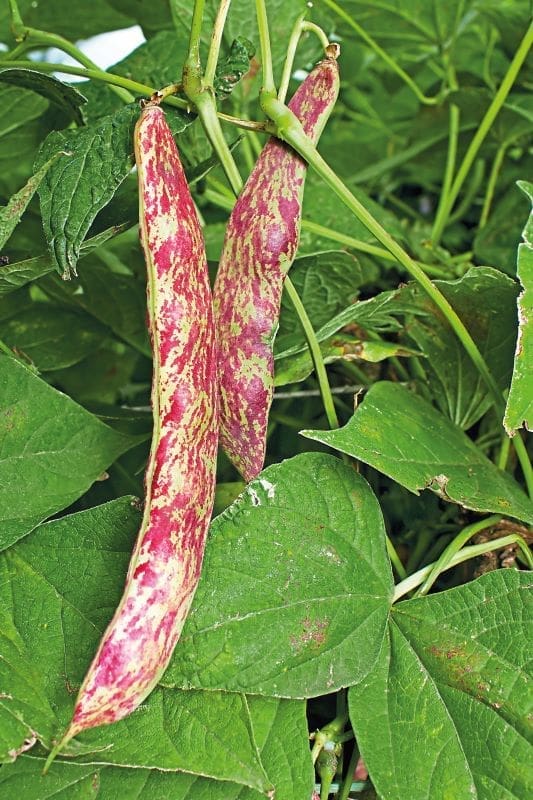
What varieties of peas and beans are good for drying?
Most seed companies sell at least a few varieties of peas or beans that are either exclusively grown for drying or are dual-purpose and can be eaten fresh while young and tender. However, most of those mentioned below are heritage types and not always easy to come by. You may well find a source online and some specialists (see suppliers below) do exist.
BEANS
Borlotti (‘Firetongue’): These beans produce attractive pods which are variously splashed with red, as are the beans themselves. Depending on the individual variety this bean can be eaten fresh or dried and Seeds of Italy has a wide range, some of which are dwarf and some climbing. Seeds of Italy and many other catalogues.
Cannellini beans: More familiar to UK cooks than some, this bean is suitable for drying or eating fresh when young. Small white beans which are great for soups and stews. Seeds of Italy.
‘Maris Bead’ broad or fava beans: Also known as pigeon peas. Available from wholefood stores, these beans were first bred 50 years ago, but broad (fava) beans are thought to be one of Britain’s oldest beans, their use dating back to the iron age.
Butter bean Stangenbohne ‘Bianco di Spagna’: aka the lima bean, a lovely bean for soups, salads and stews and also used in some home-made baked bean recipes. Available from Seeds of Italy.
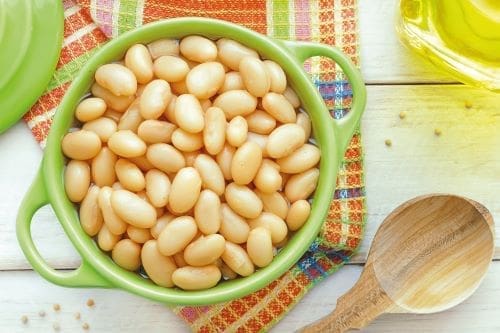
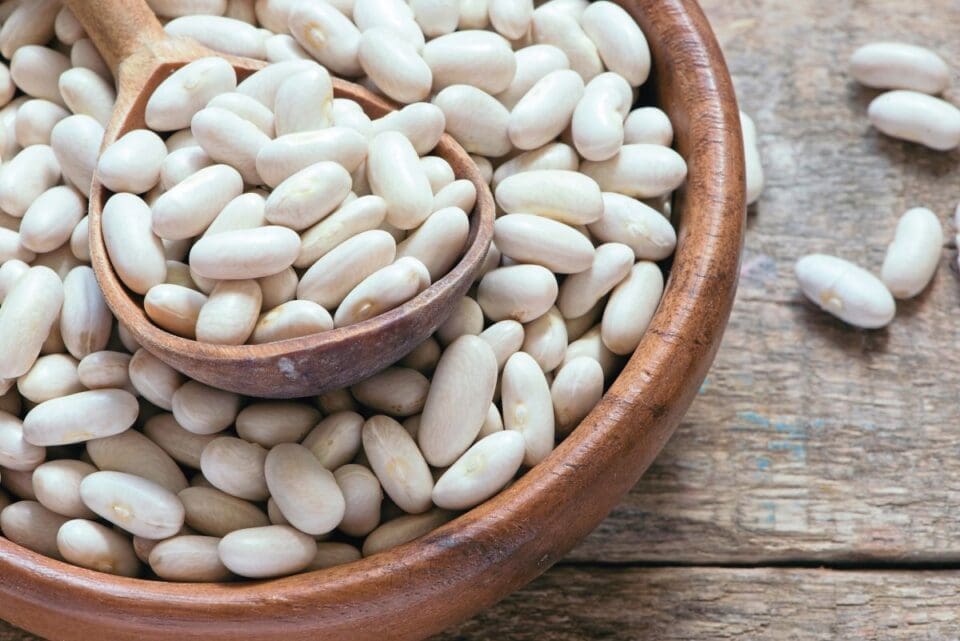

PEAS
‘Roveja’: A semi-dwarf soup pea with lovely bi-coloured purple flowers. Can be supported with pea sticks. Good for winter soups and stews. Available from Real Seeds.
‘Raatviksaart’: An ancient pea that can be eaten fresh or dried. Very hardy. Great for soups. From Real Seeds.
‘Purple Flowered Russian’: Pretty purple flowers – lots of pods containing small, round peas. From HSL.
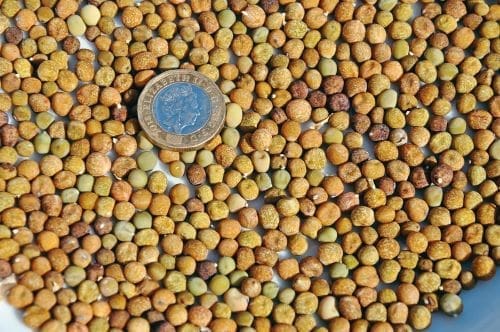
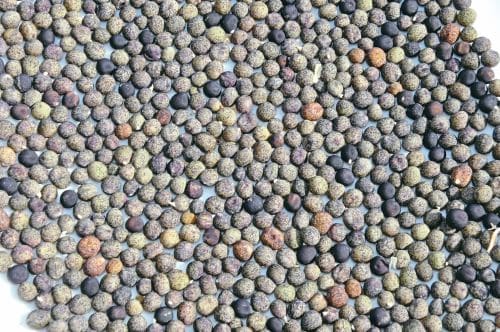
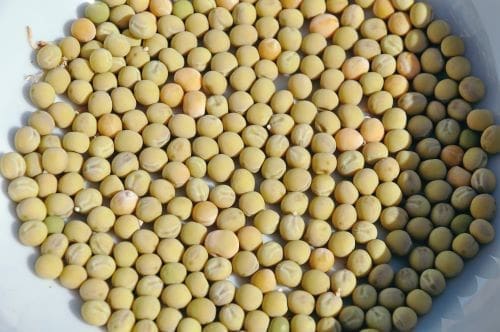
‘Holland Capucijners’: Said to have been developed by the Capuchin monks in the 1500s. Compact plants can be grown up pea sticks. Fragrant pink flowers followed by pods of large seeds ideal for use as mushy peas. From HSL.
‘Latvian’: A speckled grey pea. Plants are very productive and tall so need good supports. Great for soups and hummus. From HSL/Real Seeds.
‘Veitch’s Perfection’: A tall, white-flowered variety producing large marrowfat-type peas. HSL.
‘Carlin’: A pea thought to have been first cultivated by monks in the Middle Ages. A great substitute for chickpeas when making hummus. Available from Thomas Etty.
‘Sankia’: A tall, white-flowered pea from China. Quite productive. HSL.
